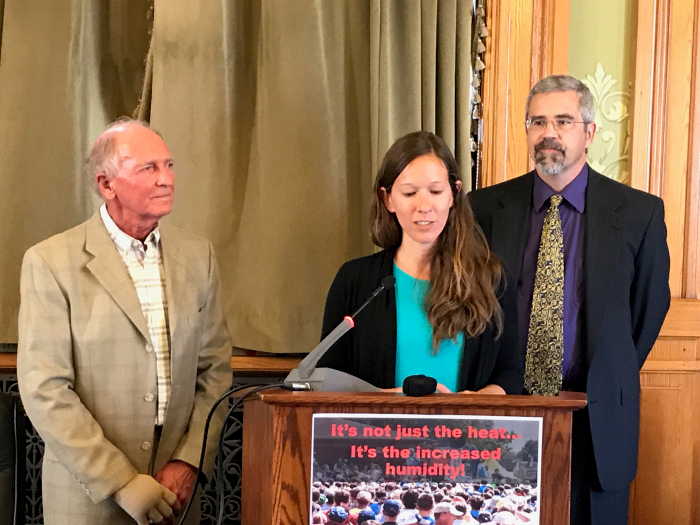College of Liberal Arts & Sciences
Iowa Climate Statement 2017: It’s not just the heat, it’s the humidity!

According to Iowa’s leading climate scientists, Iowa has experienced a significant increase in humidity levels since 1971.
The seventh annual statement, “Iowa Climate Statement 2017: It’s not just the heat, it’s the humidity!,” released Tuesday, August 9, was signed by 190 science faculty and researchers from 39 Iowa colleges and universities. The statement describes the impact of significantly higher humidity levels on people, animals, crops and infrastructure. Read the complete statement here.
“Absolute humidity, which is typically measured by dew point temperature, has increased statewide from 1971 to 2017. Measurements show Dubuque had the largest increase in humidity, a springtime increase of 23%,” said Gene Takle, Director, ISU Climate Science Program, Professor of Geological & Atmospheric Sciences, Department of Agronomy, Iowa State University.
Iowa’s increasing humidity is an important and rarely discussed result of climate change. “Besides making outside activities like visiting the State Fair more uncomfortable, increasing humidity creates conditions favorable for increased rainfall, extreme rain events, mold and mosquitoes in Iowa. Significant Increases in humidity have been measured across all seasons and at all long‐term
monitoring stations in Iowa,” said Betsy Stone, associate professor, Department of Chemistry, Department of Chemical and Biochemical Engineering at the University of Iowa.
Average increase in humidity for Iowa cities since 1971:
- Dubuque: 23 percent
- Cedar Rapids: 22.2 percent*
- Burlington: 14.8 percent
- Des Moines: 11.9 percent
- Ottumwa: 11.5 percent*
- Waterloo: 10.7 percent
- Sioux City: 9.2 percent
- Mason City: 8 percent
* Average increase since 1973
For the last six years, researchers and educators at nearly every Iowa college and university have produced annual statements on the impact of climate change on Iowans.
”Increased levels of humidity create hazardous conditions for Iowa workers and sensitive populations through the danger of heat exhaustion and heatstroke. Asthma is worsened by higher levels of allergens in the air. And the cost of air conditioning homes and businesses to maintain comfort levels increases,” said Takle, from Iowa State University.
“For Iowa’s agriculture, increased warm‐season humidity leads to water‐logged soils during planting season, rising humidity also leads to longer dew periods and higher moisture conditions that elevate costs of drying grain. Increased nighttime temperatures coupled with humidity causes stress to crops, livestock and pets,” said Takle.
“We must all do more to mitigate the effects of climate change, by curtailing emissions of heat‐trapping gases, improving energy efficiency, and increasing use of clean and renewable energy,” said Stone.
Iowa Climate Impacts
- There is clear evidence that the frequency of intense rain has increased in Iowa over the past 50 years.
- Natural systems are responding to the increase in the global average temperature. The northward expansion of species
- formerly restricted by a colder climate could disrupt natural ecosystems and introduce new agricultural pests and diseases.
- If greenhouse gas emissions continue to increase, agriculture, human health, and economic stability will be affected in new and dramatic ways.
See also this Gazette story about the Iowa Climate Statement.
The lead authors of the 2017 statement are Gene Takle, Director, ISU Climate Science Program, Professor of Geological & Atmospheric Sciences, Department of Agronomy, Iowa State University and Betsy Stone, Associate Professor, Department of Chemical and Biochemical Engineering, Department of Chemistry, University of Iowa.
Also contributing to the statement were, Jerry Schnoor, Co‐director, Center for Global and Regional Environmental Research, University of Iowa; David Courard‐Hauri, Associate Professor, Director, Environmental Science and Policy Program, Drake University; David A. Swenson, Associate Scientist, Department of Economics, Iowa State University; Peter S. Thorne, Professor and Head, Occupational & Environmental Health, Director, Environmental Health Sciences Research Center, College of Public Health, University of Iowa; Greg Carmichael, Co‐director, Center for Global and Regional Environmental Research, University of Iowa, David Osterberg, Clinical Professor, Occupational & Environmental Health, College of Public
Health, University of Iowa and Kamyar Enshayan, Director, Center for Energy & Environmental Education, University of Northern Iowa.
The 39 Colleges and Universities of statement endorsers:
Buena Vista University
Central College
Clarke University
Clinton Community College
Coe College
Cornell College
Des Moines Area Community College
Des Moines University
Dordt College
Drake University
Eastern Iowa Community College
Ellsworth Community College
Grinnell College
Indian Hills Community College
Iowa Central Community College
Iowa Lakes Community College
Iowa State University
Iowa Valley Community College
Iowa Western Community College
Kirkwood Community College
Luther College
Maharishi University of Management
Morningside College
Mount Mercy University
Northeast Iowa Community College
Northwestern College
Scott Community College
Simpson College
Southeastern Community College
Southwestern Community College
Saint Ambrose University
University of Dubuque
University of Iowa
University of Northern Iowa
Upper Iowa University
Waldorf College
Wartburg College
Western Iowa Tech Community College
William Penn University
Endorser affiliations are for identification purposes only and do not reflect views of their academic institutions.
Photo: Gene Takle, director of the Iowa State University Climate Science Program; Betsy Stone, associate professor in the University of Iowa Department of Chemical and Biological Engineering; and David Courard-Hauri, director of the Environmental Science and Policy Program at Drake University, speak at a press conference for the 2017 Iowa Climate Statement. Takle, Stone, and Courard-Hauri contributed to the statement, which focuses on how increased humidity is a side effect of climate change. (CGRER/Joe Bolkcom)